401 Oberlin Demolished — With it, a Ghost of the Cold War
After a long demolition process that lasted about a week, the last remaining section of 401 Oberlin Road was finally torn down. The once beautiful midcentury modern building was razed in order to make way for a multifamily rental structure.
A lesser known bit of trivia about this building is the purpose it served during the Cold War. The basement contained a secret civil defense bunker for the U.S. Government to be used in the event of a nuclear attack.
An Open Secret
Several years ago, the News & Observer included a bit of history about 401 Oberlin’s past in the context of an article about the Big Hole communications center in Chatham County. Sadly, that article is no longer available online. In it, N&O staff writer Jay Price states that:
The basement [of 401 Oberlin] would have housed top federal officials in the area and was equipped so they could do their best to maintain control and order after a nuclear attack. Sophisticated communications gear, a massive generator, an oversized decontamination shower area and a hefty supply of food and water were there.
Going Underground in the Atomic Age
During the Cold War, the threat of nuclear attack from the Soviet Union kept many Americans on edge. Underground shelters were touted as a way to survive the fallout from a nuclear blast. There are many of these shelters throughout Downtown Raleigh:
The government had an answer. Take over several state and federal office buildings and turning them into fallout shelters. And 30 years ago you didn’t have to look far to find them.
Fallout shelter signs hung on almost every old building along the Raleigh’s Fayetteville Street Mall. Even the basement of the state Capitol Building was stocked with food and medical supplies.
Unlike the shelters on Fayetteville Street, the complex in Cameron Village was intended for the Federal Government to restore law and order after an attack, rather than just a place for citizens to survive.
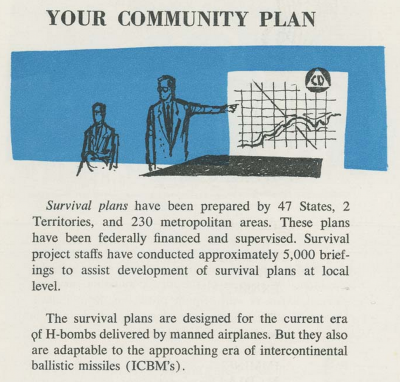
From the booklet: ‘What You Should Know About the National Plan for Civil Defense and Defense Mobilization,’ published 1958
At the time of construction in 1957, America was demonstrating its might with nuclear weapons and the Soviet Union launched the first satellite into space, Sputnik-1. America was in an arms race, and there was a real fear that there could be nuclear war, as demonstrated by this testimony to congress:
On March 11, 1955, […] Civil Defense Administrator Val Peterson told a Senate Armed Services Subcommittee that all citizens should build some sort of underground shelter “right now,” stocked with sufficient food and water to last 5 or 6 days. His recommendation was based on knowledge of what a hydrogen bomb might do when intercontinental guided missiles are perfected. When that happens, he said, “we had all better dig and pray. In fact, we had better be praying right now.”
Two years after this testimony, one of the new buildings within Cameron Village housed a top secret facility with communications equipment and provisions to survive a nuclear disaster. There were many other similar installations across the country built at the same time.
A Tunnel Under Oberlin Road?
There are rumors of a tunnel that connected the command center to another substructure across the street below the former Balentine’s Cafeteria. However, there didn’t appear to be any evidence of this when that building was torn down recently to make way for another rental development project.
Unfortunately, we may never know what the command center looked like during the height of its use during the Cold War. In addition to the scant chance of any photographs from inside the secret facility, the blueprints for this structure and all others by its architect Leif Valand were lost by his executors.
Winding Down Operations
A reader recently shared their experience of working at 401 Oberlin Road, and when it ceased to operate as a communications center for the Federal Government:
“I worked on the 2nd floor along the Clark Avenue wing of the building for about 3 years (85-88) […] the basement doors under the Clark Avenue wing had federal government signs with no trespassing posted. We never saw anyone come or go. Then one day, all the doors were open and the basement looked like someone packed in a rush to vacate the place. Various communication wiring dangling in places, a few chairs over to one side, a desk or two with drawers all open. Rumor had always been the CIA had something going on down there. […]”
In the latter part of its life, part of the hidden bunker of 401 Oberlin Road served a much more mundane purpose: storage and offices for the NC Division of Waste Management.
What do you think took place here during the height of its operations? Do you have any information on this one time undisclosed location?
Further Reading
- Big Hole, Deep Secret (Independent Weekly)
- Fallout Shelters Are Not What They Used to Be (WRAL)
- West Virginia Cold War Bunker Now a Tourist Spot (NY Times)
- Civil Defense Shelters of the Soviet Union
- The National Plan for Civil Defense and Defense Mobilization (1958)
Related Articles:
- Another One Bites the Dust: 401 Oberlin to Fall
- Cameron Village: Modernism Loses; Bland/Generic Wins
- Demolished: The Balentine’s Cafeteria Building
Postscript: The Other Hidden Area Below Cameron Village
In the 1970s and 1980s, this complex wasn’t the only hidden part of Cameron Village. There was also an underground network of shops, nightclubs, and music venues. That place, the Village Subway, still holds a dear place in many hearts. Discussion of that era in Raleigh’s history still continues on weekly basis, over 4 years after the article was published.
—

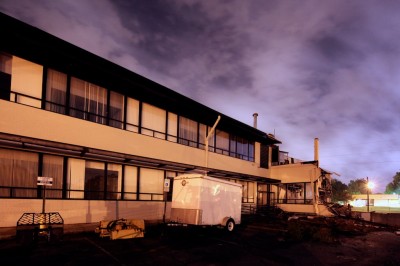

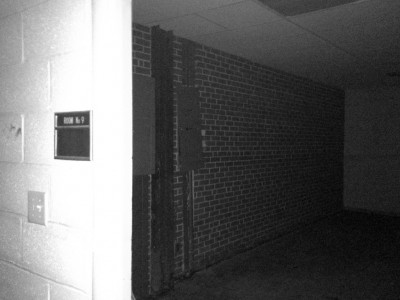

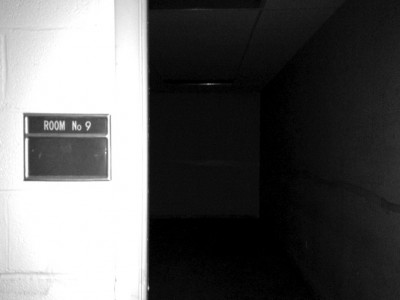
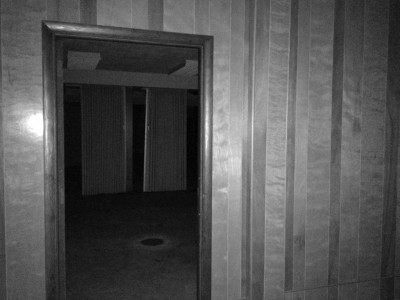
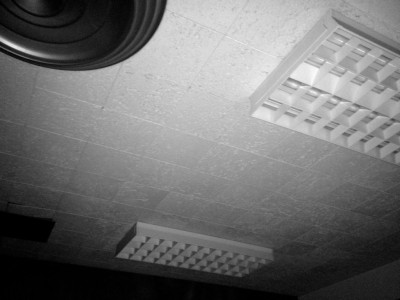
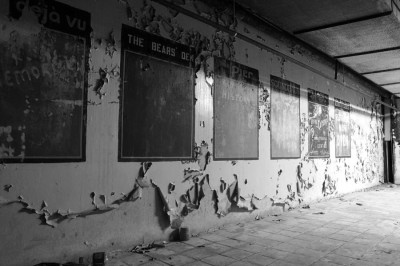

 Sign up for the Newsletter
Sign up for the Newsletter
09/26/2012
Thanks for this post. I’d never heard the story about this bunker and I’ll miss that building even more after knowing about it.
09/26/2012
I was in the basement there many times when I worked there in the late 90s and early 2000s. As far as I could tell, it was pretty much all offices and storage for NC DEHNR. The vending machines were down there also. It was definitely night the most bright and cheery place for sure.
I also remember when we were trying to get a DSL line run for our company that the phone guy said they had a hard time because there was just so much wiring running into the building.
09/26/2012
When I was in high school (’90s) a friend told me there was a rumor that Cameron Village (specifically one of the banks, I can’t remember which one) was an ICBM target of the Russians during the cold war. Makes sense now… Awesome article!
09/27/2012
How sad. My first real job was at that intersection, in the building across the street that housed Moore and Johnson Insurance Agency. It’s all wiped out and gone now – just a memory. I suppose the post office building will be next.
09/27/2012
During the excavation necessary for the below ground parking for the Gallery, across Oberlin from 401, the contractors looked very carefully for structures suggestive of the long-rumored passage under Oberlin. Although they didn’t find any evidence of a passage way, they were surprised to discover additional sub-grade office space under the lowest level of parking (under the elevated parking deck). This unexpected space was at the same level as Baileys and the Globetrotter (etc.) and may have butted up to the back of those stores. Given the known Civil Defense operations at 401, there’s no telling what efforts were made to seal things up upon the fed’s departure. Someone ought to interview Smedes York… see if he’d be willing to talk about the early days at CV.
09/27/2012
Interesting, I never knew about that shelter. When we moved to North Hills in the early 60’s there was a spec. house built next to us that had a bomb/fallout shelter. They used it as a selling point. The big question was , if you had a shelter, who would you share it with? Then what would it be like after the attack ?
10/02/2012
Thanks for the article about 401 Oberlin. Growing up in Raleigh in the 50’s and 60’s I remember hearing that the basement of that building housed some sort of secret government facility, though it always seemed likely to be just an unfounded rumor or local urban legend. Interesting to hear that there was some truth in the rumor. I drove by the site the other day during demolition, trying to see over the construction fence while remembering the old rumors.
10/12/2012
The building looked so much better, if only for a few days, without those horrible screens over the windows.
10/15/2012
I love the midcentury look but guess now they will put the typical postmodern retail/rental like on Wade and Oberlin. Traffic should be lovely, too!
10/19/2012
I drive past the former 401 Oberlin on my way to work every day. It was sad seeing it progressively get flattened each day knowing it will be replaced in true Raleigh fashion with more awful, generic, uninspired crap. I’ll be glad to get out of this city before they just level it all and start over. It didn’t seem to be occupied in the ~3 years I’ve lived near it, was it in fact in use til demolition?
BTW, Micah, couldn’t agree more on those screens!
12/10/2012
401 was my favorite building in the Cameron Village area, and one of my favorite in Raleigh, both for the design and for the way it simply owned that corner of the intersection. I can’t really describe it except to say that it just *belonged* there. With 401 gone and the Ballentine’s building gone, it’s just a matter of time before they come for the Post Office building and erase the last significant piece of modernism on the block.
I happened to drive past one of my last days in Raleigh, when I knew it was scheduled to go but not when, and saw that demolition had already started–I felt physically sick. I fear that when I come back in the future, there will be nothing left of the Raleigh I knew.
12/12/2012
Awesome stuff John. I’d never heard anything about these bunkers. Really cool.
02/26/2013
I heard of this throughout the late 70’s and 80’s including the account of a man who found himself by accident in what he described as a very long hallway with office doors off of the corridor and men in military uniforms walking about as well as civilian workers. One of them accosted him and told him he should not be down there and sent him back up. I guess this could have been true after all.
07/13/2013
When I was at NCSU in the early 1970s I was looking up a Federal agencey in the phone book and just happen to see a phone number for the CIA listed at an Oberlin Road address (I rode by later to see the building location and it was the one at 401 Oberlin). I called the phone numer and the man who answered simply repeated the phone number. True story. I swear. I always wondered why the CIA would have an office in Raleigh.
12/01/2023
For anyone that might come across this posting, there is additional information. The bunker mentioned in the posting above existed as described.
What was not mentioned was the presence of a CIA communications intercept facility located on levels (plural) below the bunker.
This lower facility would be who picked up the phone if you called the phone number mentioned in the comments above. Access to these lower floors was only via tunnels, one coming from a tunnel behind a locked door in the basement level of Cameron Village, the other from a sub level of Balentine’s.
This kind of CIA operation on domestic soil was illegal as hell. When they terminated the lower facility, the basement bunker was cleaned out as well.
There use to be postings with information on the facility available online in the late 1990s, including pictures of a MASSIVE amount of of copper phone trunking that was cut off abruptly when the facility was shut down. My understanding is the sub levels were pumped full of concrete during redevelopment of the site.
It seems like someone made an effort to clean up any online trails about what really was going on below the building over the years.